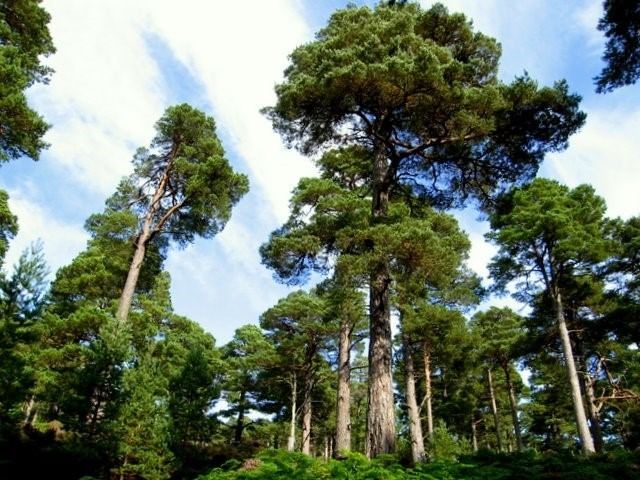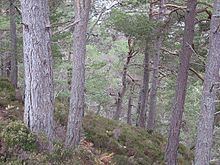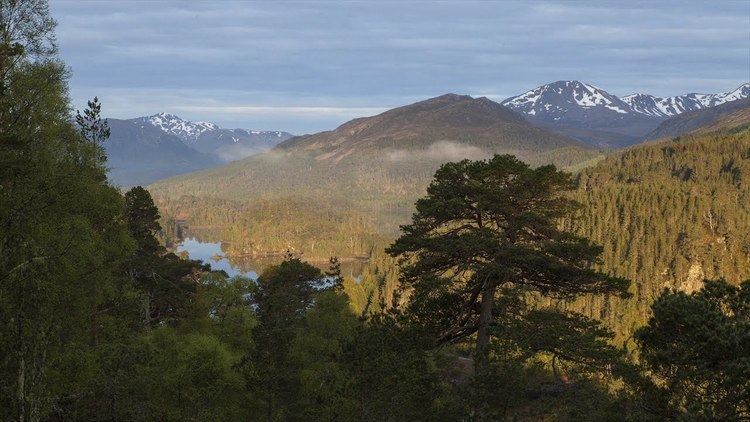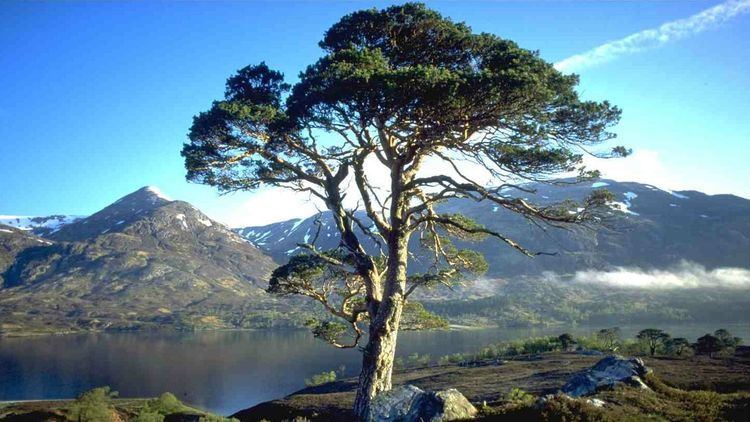 | ||
Similar | ||
Trees for life restoring the caledonian forest
The Caledonian Forest is the name given to the former (ancient old-growth) temperate rainforest of Scotland. The name comes to us from Pliny the Elder who tells us that 30 years after the Roman invasion of Britain their knowledge of it did not extend beyond the neighbourhood of silva caledonia. He gives no information about where the silva caledonia was, but the known extent of the Roman occupation suggest that it was north of the River Clyde and west of the River Tay.
Contents
- Trees for life restoring the caledonian forest
- Restoring the ancient caledonian forest alan watson featherstone tedxfindhorn
- History
- Legend and folklore
- Wildlife
- Conservation
- Reintroductions
- Remaining pinewoods
- References

The Scots pines of the Caledonian Forest are directly descended from the first pines to arrive in Scotland following the Late Glacial; arriving about 7000 BCE. The forest reached its maximum extent about 5000 BCE, after which the Scottish climate became wetter and windier. This changed climate reduced the extent of the forest significantly by 2000 BCE. From that date, human actions (including the grazing effects of sheep and deer) reduced it to its current extent.

Today, that forest exists as 35 remnants, as authenticated by Steven & Carlisle (1959)</ref> (or 84 remnants, including later subjective subdivisions of the 35) covering about 180 square kilometres (69 sq mi) or 44,000 acres (18,000 ha). The Scots pines of these remnants are, by definition, directly descended from the first pines to arrive in Scotland following the ice age. These remnants have adapted genetically to different Scottish environments, and as such, are globally unique; their ecological characteristics form an unbroken, 9000 year chain of natural evolution with a distinct variety of soils, vegetation, and animals.

To a great extent the remnants survived on land that was either too steep, too rocky, or too remote to be agriculturally useful. The largest remnants are in Strathspey and Strath Dee on highly acidic, freely drained glacial deposits that are of little value for cultivation and domestic stock. An examination of the earliest maps of Scotland suggests that the extent of the Caledonian Forest remnants has changed little since 1600.

Restoring the ancient caledonian forest alan watson featherstone tedxfindhorn
History

Following the last glacial period, trees began to recolonise what is now the British Isles over a land bridge which is now beneath the Strait of Dover. Forests of this type were found all over what is now the island of Great Britain for a few thousand years, before the climate began to slowly warm in the Atlantic period, and the temperate coniferous forests began retreating north into the Scottish Highlands, the last remaining climatic region suitable for them in the British Isles (see Climate of Scotland).
The native pinewoods which formed this westernmost outpost of the taiga of post-glacial Europe are estimated to have covered 15,000 km2 (3,700,000 acres) as a vast wilderness of Scots pine, birch, rowan, aspen, juniper, oak and a few other hardy species. On the west coast, oak and birch predominated in a temperate rainforest ecosystem rich in ferns, mosses and lichens.
Legend and folklore
In the Matter of Britain, the forest is the site of one of King Arthur's Twelve Battles, according to the Historia Brittonum, in which the battle is called Cat Coit Celidon. Scholars Rachel Bromwich and Marged Haycock suggest that the army of trees animated by sorcerers in the Old Welsh poem Cad Goddeu ("Battle of the Trees") are intended to be the Caledonian Forest.
In related Merlin literature, the figure of Myrddin Wyllt retreated to these woods in his madness after the Battle of Arfderydd in the year 573. He fled from the alleged wrath of the king of Strathclyde, Rhydderch Hael, after the slaying of Gwenddoleu ap Ceidio. This is written in the two Merlinic poems in Middle Welsh Yr Oinau and Yr Afallenau in the Black Book of Carmarthen. The forest is also the retreat of another character named Lailoken from the Vita Kentigerni, who also fled into the woods in a fit of madness and who may be the original model for Myrddin Wyllt.
In the Middle Welsh story Culhwch and Olwen, the main character Culhwch is the son of a king named Celyddon Wledig, who may or may not be related to the forest in name. Another figure from the same story, Cyledyr Wyllt hints at a close relationship of the forest being a retreat for people who suffered from a special kind of madness or gwyllt (Irish geilt). In line 994 to 996 of the story, it is briefly explained, "a Chyledyr Wyllt y uab, a llad Nwython a oruc a diot y gallon, a chymhell yssu callon y dat, ac am hynny yd aeth Kyledyr yg gwyllt" ("and his son Kyledyr the Wild. Gwynn killed Nwython and cut out his heart, and forced Kyledyr to eat his father's heart, and that is how Kyledyr went mad"). Though not named directly, the very name Kyledyr Wyllt is close to the two related notions of the forest of Celyddon being where people suffering madness or gwyllt hide.
Wildlife
Being a unique ecosystem in the British Isles, the Caledonian Pinewoods are home to some of the country's rarest wildlife. It is considered to be one of the last remaining wildernesses in the British Isles.
Breeding bird species in Caledonian pine forests found breeding nowhere else in the British Isles:
Breeding bird species in Caledonian pine forests rare elsewhere in the British Isles:
Mammal species present in Caledonian pine forests:
Mammal species extinct in Caledonian pine forests:
Conservation
A review of the native pinewoods of Scotland Steven & Carlisle (1959) highlighted the plight of the remaining 35 ancient pinewood sites, many of which had been damaged by felling, Fire and intensive grazing from sheep and deer. A later review in the 1980s showed that further damage had occurred through ploughing and planting with non-native conifers with less than 12,000 ha of the ancient habitat remaining. A subsequent guide to the ancient pinewoods reviews the conservation story and provides a summary of the management in each site as well as a guide on how to reach all the woods using public transport walking and cycling Much of remaining Caledonian pine forest is fully protected, and much of the forest now lies within the Cairngorms National Park. The Royal Society for the Protection of Birds (RSPB) and the Forestry Commission also own several areas of pinewood on their reserves. One of the largest remaining areas is Ballochbuie Forest on the Balmoral Estate, which is protected as a Special Area of Conservation under the European Union Habitats Directive.
Scientific research continues on the ecology of the Caledonian Forest and its restoration. Populations of the rare groundcover, Linnaea borealis, may be too isolated from one another to produce viable seed. Diversity of fungi has also been affected by the decrease in habitat. The agaric fungus Mycena purpureofusca is commonly found in Caledonian pine woods, and it is considered an indicator species for that habitat type. Fire appears to increase the natural recruitment of Scots pine seedlings.
Reintroductions
In recent years, there has been a growing interest to reintroduce animals which are currently extinct in Great Britain, back into Caledonian pine forests. Corporations have been set up to persuade the government to allow this. The long-running campaign to reintroduce the Eurasian beaver to Knapdale in Argyll has been successful, and there is some support for the reintroduction of the gray wolf and Eurasian lynx.
Recently, some landowners have announced plans to build large game reserves on their land and release the species within them. Paul Lister plans to release Eurasian lynx, brown bear, grey wolf, elk, wild boar and species already present in Scotland into a huge 200 km2 (49,000-acre) enclosure at his estate, Alladale Wilderness Reserve, although releasing top predators such as wolves and bears has become a difficult proposition with local and national regulations. An initial trial enclosure of 5.5 km2 (1,400 acres) was built with elk, wild boar, Red deer and roe deer.
Remaining pinewoods
Bain (2013) lists 38 ancient pinewood sites in Britain which have been identified as the most genuinely native and natural. All of them occur in the Scottish Highlands. The Caledonian Pinewood Inventory identifies 84 pinewood sites which includes smaller sub-units of the main sites. A new comprehensive survey of the native woodlands of Scotland from Forestry Commission Scotland and supported by Scottish Natural Heritage is due to be completed in 2014.
